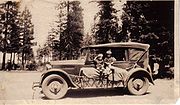
National Primitive Area
Encyclopedia

United States Forest Service
The United States Forest Service is an agency of the United States Department of Agriculture that administers the nation's 155 national forests and 20 national grasslands, which encompass...
. Although there are still lands with this title, most are now known as wilderness areas.
The Forest Service began this new designation in 1929 with the L-20 regulations.
The L-20 regulations defined three types of areas: Natural Area, Experimental Forest and Range, and Primitive Area. The L-20 section on Primitive Area read, "to maintain primitive conditions of transportation, subsistence, habitation, and environment to the fullest degree compatible with their highest public use." as stated by M. Rupert Cutler, in a briefing before the Subcommittee on Public Lands of the Committee on Interior and Insular Affairs, U.S. House of Representatives on July 24. 1979.
The US Forest Service, along with preservationist Bob Marshall
Bob Marshall (wilderness activist)
Robert "Bob" Marshall was an American forester, writer and wilderness activist. The son of wealthy constitutional lawyer and conservationist Louis Marshall, Bob Marshall developed a love for the outdoors as a young child...
, continued to add acreage to the fledgling wilderness system.
[Marshall’s] total acreage recommendation to the Forest Service for
primitive classification was almost three times more than the Service
was willing or able to set aside. Areas in which the Park Service had
shown a special interest, however, were almost all formally classified
as primitive areas—even those under 100000 acres (404.7 km²) in the West which
were not of special interest to Marshall.
Stricter regulations for these new protected areas began in 1939 from Bob Marshall's efforts. This resulted in the "U-Regulations" as they came to be known.
The U-Regulations superseded the L-20 Regulations and created two types of areas. Regulation U-1 created Wilderness Areas (over 100,000 acres). Regulation U-2 created Wild Areas (5,000 to 100,000 acres]]. The U Regulations prohibited mechanized access, timber harvesting and road construction in the wilderness and wild areas.
The U-Regulations replaced the term primitive area with wilderness area and wild area and were used by the Forest Service until the passage of the federal Wilderness Act
Wilderness Act
The Wilderness Act of 1964 was written by Howard Zahniser of The Wilderness Society. It created the legal definition of wilderness in the United States, and protected some 9 million acres of federal land. The result of a long effort to protect federal wilderness, the Wilderness Act was signed...
of 1964.
The Wilderness Act gave federal protection to these US Forest Service administrative areas and created the National Wilderness Preservation System
National Wilderness Preservation System
The National Wilderness Preservation System of the United States protects federally managed land areas designated for preservation in their natural condition. It was established by the Wilderness Act upon the signature of President Lyndon B. Johnson on September 3, 1964...
.

